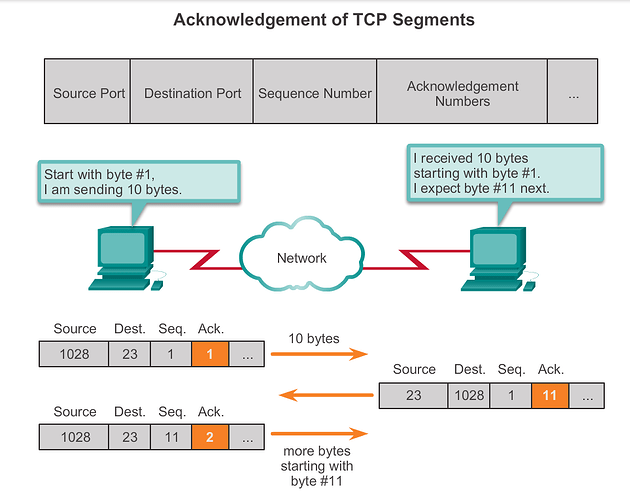Hello Azm
Yes, these numbers can be confusing. Here is an attempt to clarify these parameters:
The first thing to keep in mind is that in any TCP communication, there are actually TWO sequence numbers and TWO acknowledgement numbers: those of each party in the exchange of data. For the sake of this example, and for the diagram below, let’s call these SNL and SNR for Sequence Number Left and Sequence Number Right for the left and right hosts. Similarly, the acknowledgement numbers will be called ANL and ANR.
Note, these abbreviations are my own and are not generally accepted. I am using them only for the purpose of this example.
Take a look at this diagram:
The current state of this diagram is when the three way handshake has already been completed and transmission of data has begun. The current window size is 10.
So, the left host begins transmitting and sends a frame where SNL is 1 and ANL is 1. The SNL and ANL have been determined after the procedure of the three way handshake. (To find out how these are initially determined, take a look at Rene’s lesson here: https://networklessons.com/cisco/ccna-routing-switching/introduction-to-tcp-and-udp/ )
Since the window size is 10, the left host will send 10 bytes (this can be sent in one or more segments) and the header of the segment will have an SNL of 1 and an ANL of 1. Once 10 bytes are sent (the window size) the left host will stop.
The right host will continue to receive data and will do nothing until 10 bytes have been received. Once they have been received, it will compose an acknowledgement segment with the following information:
SNR = 1 This has been determined after the three way handshake. Note this is independent of the SNL
ANR = SNL + window size = 11 This essentially is the number of the next expected byte
Once this acknowledgement segment is received by the left host, it prepares the next batch of bytes to be sent, specifically, 10 since the window size is 10. In the segment it sends, it puts the following values:
SNL = ANR = 11
ANL = SNR + 1 = 2
And the process continues.
I hope this has been helpful!
Laz
